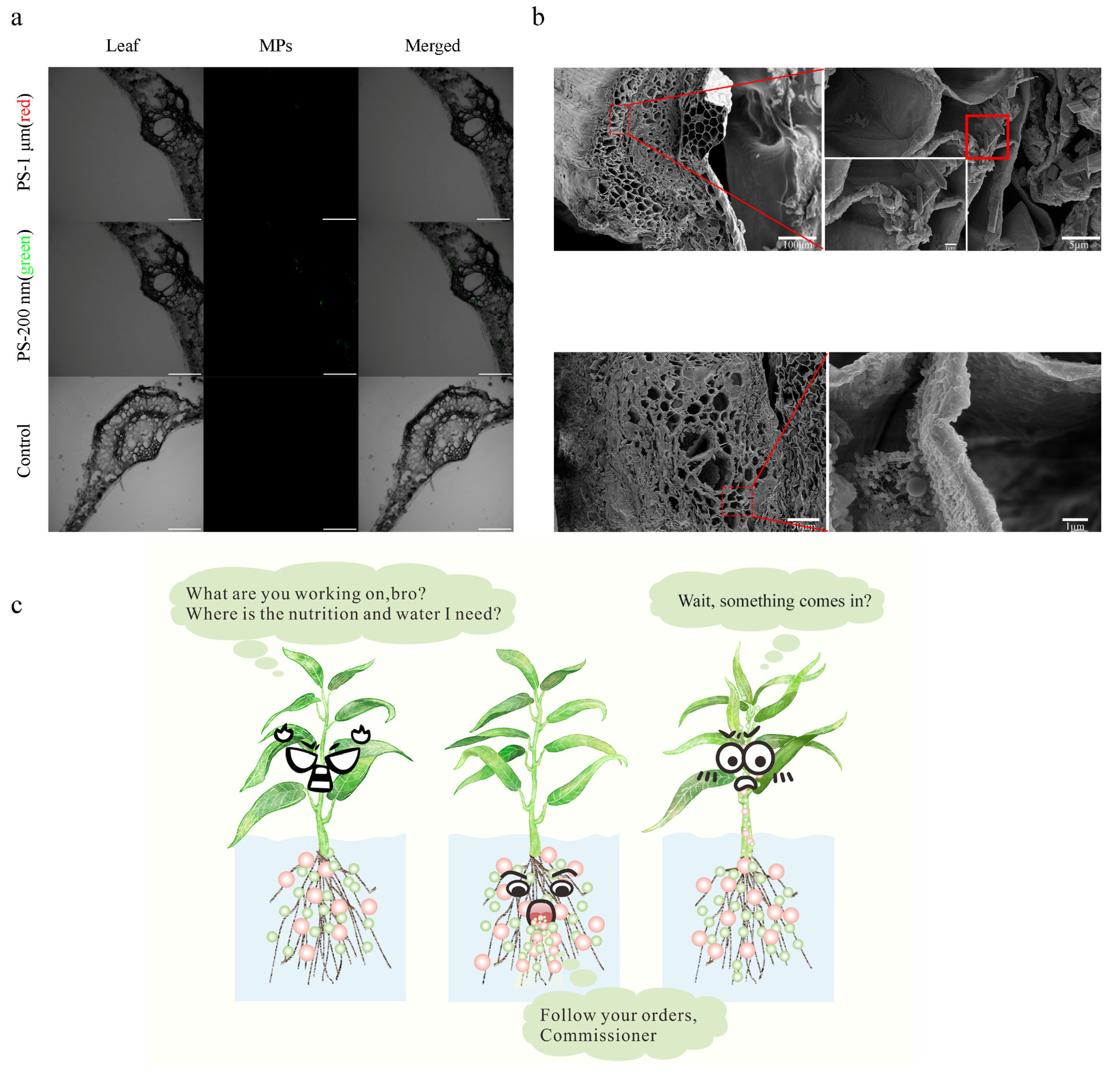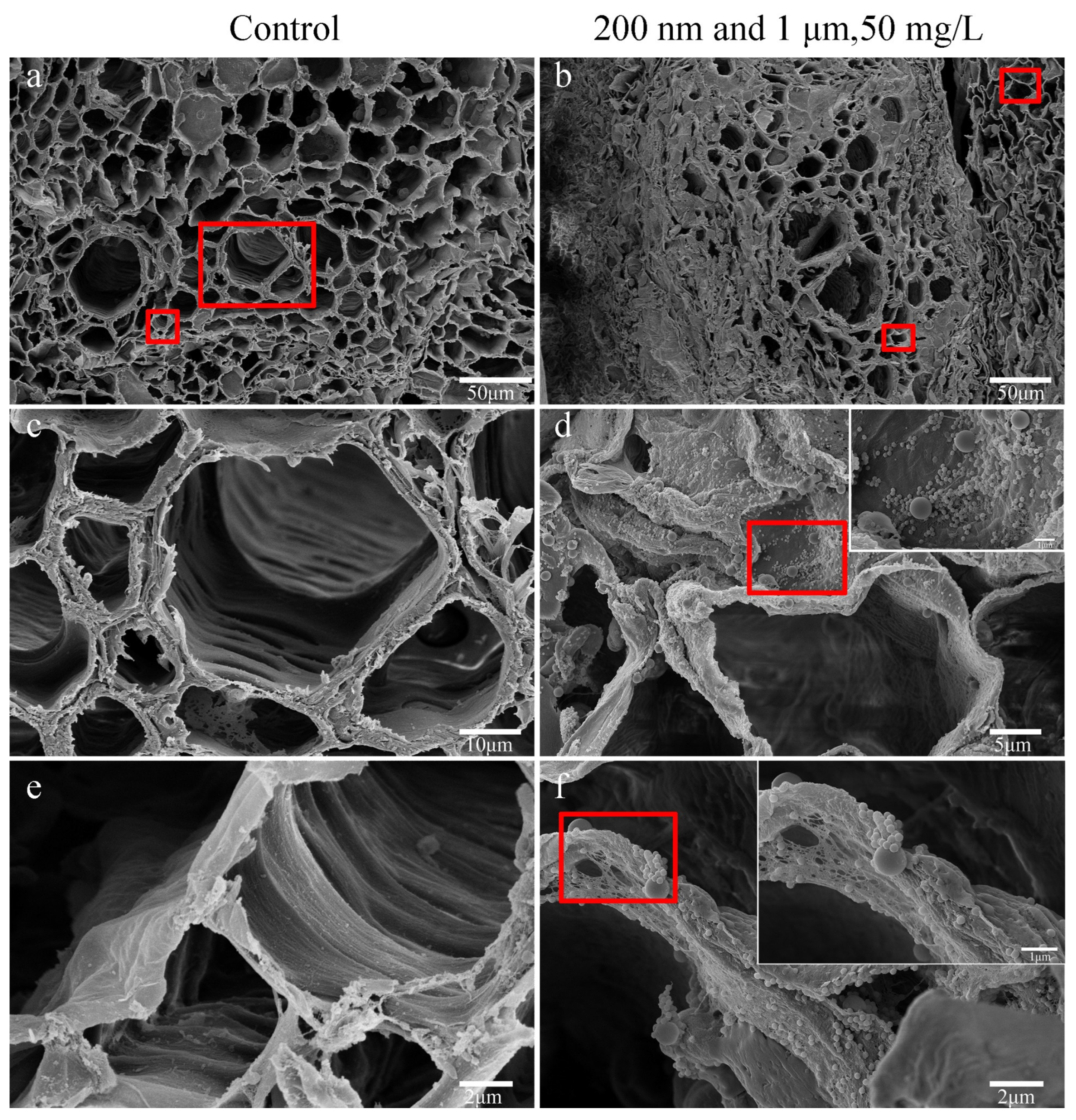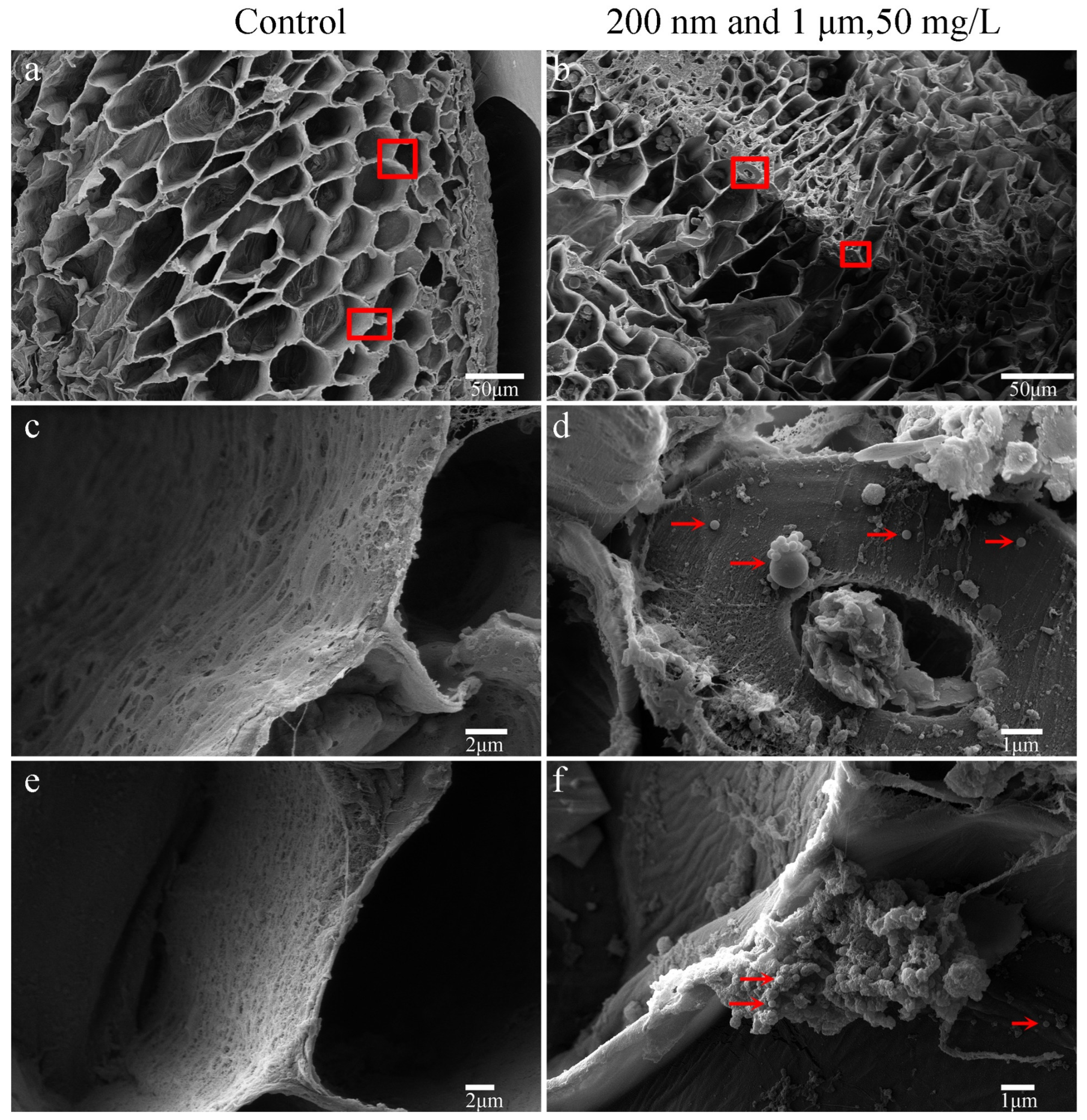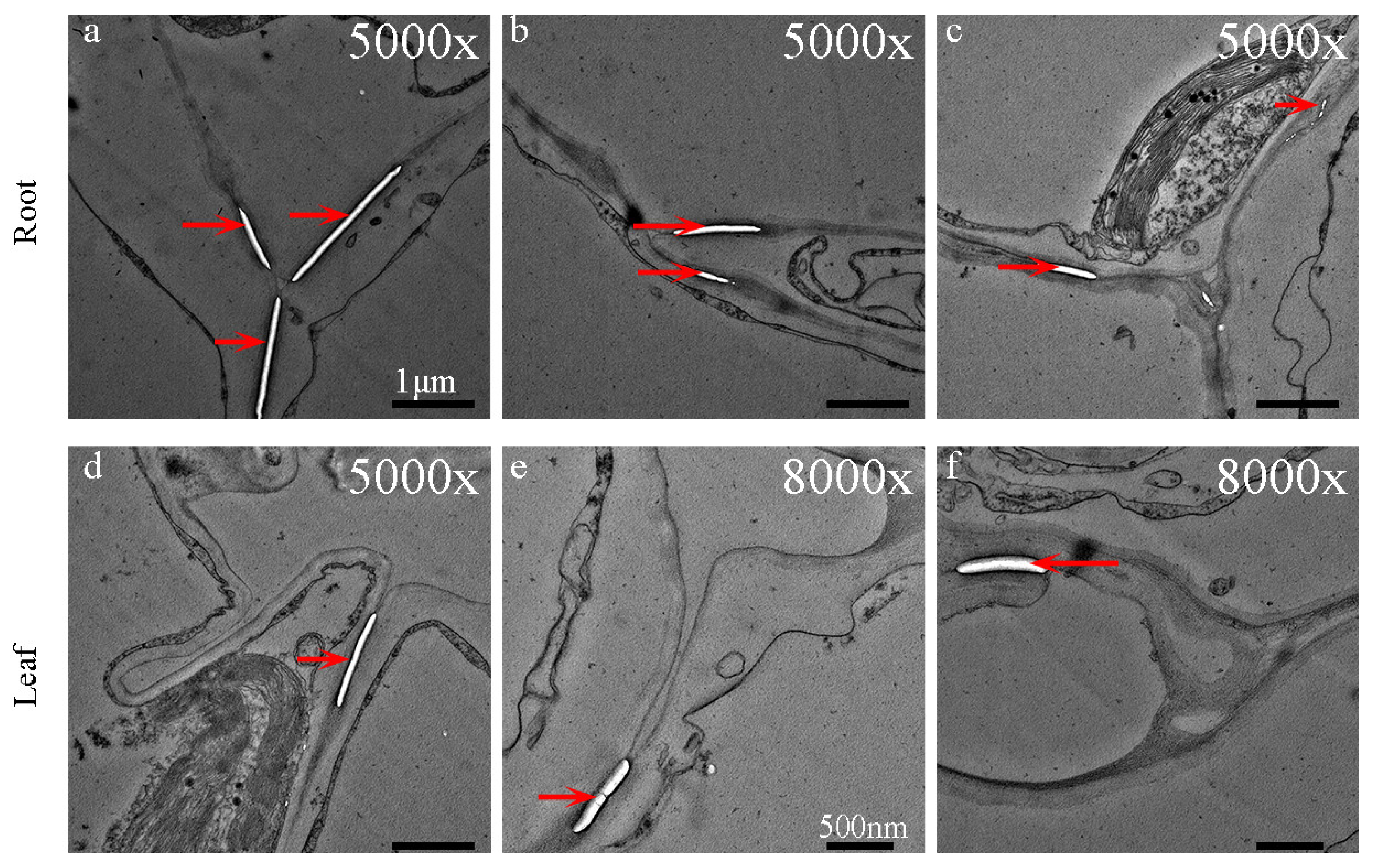Water Spinach (Ipomoea aquatica F.) Effectively Absorbs and Accumulates Microplastics at the Micron Level—A Study of the Co-Exposure to Microplastics with Varying Particle Sizes
Abstract
1. Introduction
2. Materials and Methods
2.1. PS Beads
2.2. Plant Materials and Cultivation Conditions
2.3. Transmission Electron Microscopy
2.4. SEM
2.5. Laser Scanning Confocal Microscopy
3. Results and Discussion
3.1. Larger Size PS-MPs Are Absorbed under the Influence of Submicron PS-MPs
3.2. PS-MPs Are Transported to the Plant Aboveground Tissues by the Vascular System and Accumulate in Significant Quantities in the Edible Parts of Vegetables
3.3. Leafy Vegetables May Take up Large Amounts of MPs
4. Conclusions
Supplementary Materials
Author Contributions
Funding
Institutional Review Board Statement
Data Availability Statement
Acknowledgments
Conflicts of Interest
References
- Liu, Y.; Ben, Y.; Che, R.; Peng, C.; Li, J.; Wang, F. Uptake, transport and accumulation of micro- and nano-plastics in terrestrial plants and health risk associated with their transfer to food chain—A mini review. Sci. Total Environ. 2023, 902, 166045. [Google Scholar] [CrossRef]
- He, X.; Qian, Y.; Li, Z.; Yang, S.; Tian, J.; Wang, Q.; Lei, J.; Qi, R.; Feng, C. Identification of factors influencing the microplastic distribution in agricultural soil on Hainan Island. Sci. Total Environ. 2023, 874, 162426. [Google Scholar] [CrossRef] [PubMed]
- Cao, L.; Wu, D.; Liu, P.; Hu, W.; Xu, L.; Sun, Y.; Wu, Q.; Tian, K.; Huang, B.; Yoon, S.; et al. Occurrence, distribution and affecting factors of microplastics in agricultural soils along the lower reaches of Yangtze River, China. Sci. Total Environ. 2021, 794, 148694. [Google Scholar] [CrossRef] [PubMed]
- Hossain, M.; Rahman, M.; Afrin, S.; Akbor, A.; Siddique, M.; Malafaia, G. Identification and quantification of microplastics in agricultural farmland soil and textile sludge in Bangladesh. Sci. Total Environ. 2023, 858, 160118. [Google Scholar] [CrossRef] [PubMed]
- Mercogliano, R.; Avio, C.; Regoli, F.; Anastasio, A.; Colavita, G.; Santonicola, S. Occurrence of Microplastics in Commercial Seafood under the Perspective of the Human Food Chain. A Review. J. Agric. Food Chem. 2020, 68, 5296–5301. [Google Scholar] [CrossRef]
- Zhu, H.; Fu, S.; Zou, H.; Su, Y.; Zhang, Y. Effects of nanoplastics on microalgae and their trophic transfer along the food chain: Recent advances and perspectives. Environ. Sci. Proc. Imp. 2021, 23, 1873–1883. [Google Scholar] [CrossRef] [PubMed]
- Okeke, E.; Okoye, C.; Atakpa, E.; Ita, R.; Nyaruaba, R.; Mebechidinma, C.; Akan, O. Microplastics in agroecosystems-impacts on ecosystem functions and food chain. Resour. Conserv. Recy. 2022, 177, 105961. [Google Scholar] [CrossRef]
- Khan, N.; Khan, A.; López-Maldonado, E.; Alam, S.; López, J.; Herrera, P.; Mohamed, B.; Mahmoud, A.; Abutaleb, A.; Singh, L. Micrplastic:Occurrences, treatment methods, regulations and foreseen environmental impacts. Environ. Res. 2022, 215, 114224. [Google Scholar] [CrossRef] [PubMed]
- Xie, S.; Zhang, R.; Li, Z.; Liu, C.; Chen, Y.; Yu, Q. Microplastics perturb colonicepithelial homeostasis associated with intestinal overproliferation, exacerbating the severity of colitis. Environ. Res. 2023, 217, 114861. [Google Scholar] [CrossRef]
- Zha, H.; Xia, J.; Li, S.; Lv, J.; Zhuge, A.; Tang, R.; Wang, S.; Wang, K.; Chang, K.; Li, L. Airborne polystyrene microplastics and nanoplastics induce nasal and lung microbial dysbiosis in mice. Chemosphere 2023, 310, 136764. [Google Scholar] [CrossRef]
- Kwon, W.; Kim, D.; Kim, H.Y.; Jeong, S.W.; Lee, S.G.; Kim, H.C.; Lee, Y.J.; Kwon, M.K.; Hwang, J.S.; Han, J.E.; et al. Microglial phagocytosis of polystyrene microplastics results in immune alteration and apoptosis in vitro and in vivo. Sci. Total Environ. 2022, 807, 150817. [Google Scholar] [CrossRef] [PubMed]
- Koner, S.; Florance, I.; Mukherjee, A.; Chandrasekaran, N. Cellular response of THP-1 macrophages to polystyrene microplastics exposure. Toxicology 2023, 483, 153385. [Google Scholar] [CrossRef] [PubMed]
- Li, R.; Li, L.; Zhang, Y.; Yang, J.; Tu, C.; Zhou, Q.; Li, Y.; Luo, Y. Uptake and accumulation of microplastics in a cereal plant wheat. Chin. Sci. Bull. 2020, 65, 2120–2127. (In Chinese) [Google Scholar] [CrossRef]
- Li, Z.; Li, R.; Zhou, J.; Wang, G. The distribution and impact of polystyrene nanoplastics on cucumber plants. Environ. Sci. Pollut. Res. 2020, 28, 16042–16053. [Google Scholar] [CrossRef] [PubMed]
- Li, L.; Zhou, Q.; Yin, N.; Tu, C.; Luo, Y. Uptake and accumulation of microplastics in an edible plant. Chin. Sci. Bull. 2019, 64, 928–934. (In Chinese) [Google Scholar] [CrossRef]
- Gao, D.; Liao, H.; Junaid, M.; Chen, X.; Kong, C.; Wang, Q.; Pan, T.; Chen, G.; Wang, X.; Wang, J. Polystyrene nanoplastics’ accumulation in roots induces adverse physiological and molecular effects in water spinach Ipomoea aquatica Forsk. Sci. Total Environ. 2023, 872, 162278. [Google Scholar] [CrossRef]
- Yu, F.; Fu, M.; Tang, C.; Mo, C.; Li, S.; Luo, S.; Qin, P.; Zhao, Y.; Li, Y. Potential impact of polyethylene microplastics on the growth of water spinach (Ipomoea aquatica F.): Endophyte and rhizosphere effects. Chemosphere 2023, 330, 138737. [Google Scholar] [CrossRef]
- Wang, L.; Liu, B.; Zhang, W.; Li, Q.; Lin, B.; Wei, C. An unrecognized entry pathway of submicrometre plastics into crop root:The split of hole in protective layer. J. Hazard Mter. 2023, 457, 131732. [Google Scholar] [CrossRef]
- Sun, X.; Yuan, X.; Jia, Y.; Feng, L.; Zhu, F.; Dong, S.; Liu, J.; Kong, X.; Tian, H.; Duan, J.; et al. Differentially charged nanoplastics demonstrate distinct accumulation in Arabidopsis thaliana. Nat. Nanotechnol. 2020, 15, 755–760. [Google Scholar] [CrossRef] [PubMed]
- Li, L.; Luo, Y.; Li, R.; Zhou, Q.; Peijnenburg, W.; Yin, N.; Yang, J.; Tu, C.; Zhang, Y. Effective uptake of submicrometre plastics by crop plants via a crack-entry mode. Nat. Sustain. 2020, 3, 929–937. [Google Scholar] [CrossRef]
- Liu, Y.; Guo, R.; Zhang, S.; Sun, Y.; Wang, F. Uptake and translocation of nano/microplastics by rice seedlings: Evidence from a hydroponic experiment. J. Hazard. Mter. 2022, 421, 126700. [Google Scholar] [CrossRef]
- Li, Z.; Li, R.; Li, Q.; Zhou, J.; Wang, G. Physiological response of cucumber (Cucumis sativus L.) leaves to polystyrene nanoplastics pollution. Chemosphere 2020, 255, 127041. [Google Scholar] [CrossRef]
- Morioka, T.; Tanaka, S.; Yamada, Y.; Yukioka, S.; Aiba, F. Quantification of microplastic by particle size down to 1.1 μm in surface road dust in an urban city. Jpn. Environ. Pollut. 2023, 334, 122198. [Google Scholar] [CrossRef] [PubMed]
- Wang, Y.; Chen, X. Aggregation behavior of polyethylene microplastics in the nearshore environment: The role of particle size, environmental condition and turbulent flow. Sci. Total Environ. 2023, 901, 165941. [Google Scholar] [CrossRef] [PubMed]
- Dong, Y.; Gao, M.; Qiu, W.; Song, Z. Uptake of microplastics by carrots in presence of As (III):Combined toxic effects. J. Hazard. Mter. 2021, 411, 125055. [Google Scholar] [CrossRef] [PubMed]
- Doblas, V.; Geldner, N.; Barberon, M. The endodermis, a tightly controlled barrier for nutrients. Curr. Opin. Plant. Biol. 2017, 39, 136–143. [Google Scholar] [CrossRef] [PubMed]
- EI-Showk, S.; Mähönen, A. A cellular passage to the root interior. Nature 2018, 555, 454–455. [Google Scholar] [CrossRef]
- Liu, Y.; Xu, G.; Teng, H.; Liu, B.; Yu, Y. Effects of micro- and nano-plastics on accumulation and toxicity of pyrene in water spinach (Ipomoea aquatica Forsk). Environ. Sci. Pollut. Res. 2022, 30, 956–965. [Google Scholar] [CrossRef]
- Huang, L.; Sun, X.; Gui, Q.; Ouyang, J. Effects of plant polysaccharides with different carboxyl group contents on calcium oxalate crystal growth. CrystEngComm 2017, 19, 4838–4847. [Google Scholar] [CrossRef]
- Göthberg, A.; Greger, M.; Bengtsson, B. Accumulation of heavy metals in water spinach (Ipomoea aquatica) cultivated in the Bangkok region, Thailand. Environ. Toxicol. Chem. 2002, 21, 1934–1939. [Google Scholar] [CrossRef]
- Luo, Y.; Li, L.; Feng, Y.; Li, R.; Yang, J.; Peijnenburg, W.; Tu, C. Quantitative tracing of uptake and transport of submicrometre plastics in crop plants using lanthanide chelates as a dual-functional tracer. Nat. Nanotechnol. 2022, 17, 424–431. [Google Scholar] [CrossRef] [PubMed]
- Liu, Y.; Xiao, M.; Shahbaz, M.; Hu, Z.; Zhu, Z.; Lu, S.; Yu, Y.; Yao, H.; Chen, J.; Ge, T. Microplastics in soil can increase nutrient uptake by wheat. J. Hazard. Mter. 2022, 438, 129547. [Google Scholar] [CrossRef] [PubMed]
- Tong, Y.; Ding, J.; Xiao, M.; Shahbaz, M.; Zhu, Z.; Chen, M.; Kuzyakov, Y.; Deng, Y.; Chen, J.; Ge, T. Microplastics affect activity and spatial distribution of C, N, and P hydrolases in rice rhizosphere. Soil Ecol. Lett. 2023, 5, 220138. [Google Scholar] [CrossRef]
- Xu, J.; Zuo, R.; Shang, J.; Wu, G.; Dong, Y.; Zheng, S.; Xu, Z.; Liu, J.; Xu, Y.; Wu, Z.; et al. Nano- and micro-plastic transport in soil and groundwater environments:Sources, behaviors, theories, and models. Sci. Total Environ. 2023, 904, 166641. [Google Scholar] [CrossRef] [PubMed]
- Lu, X.; Lu, P.; Liu, X. Fate and abundance of antibiotic resistance genes on microplastics in facility vegetable soil. Sci. Total Environ. 2020, 709, 136276. [Google Scholar] [CrossRef] [PubMed]
- Chen, G.; Wang, Q.; Li, H.; He, J.; Lu, C.; Xu, D.; Sun, M. Experimental research on a propeller blade fertilizer transport device based on a discrete element fertilizer block model. Comput. Electron. Agric. 2023, 208, 107781. [Google Scholar] [CrossRef]
- Battisti, C.; Dodaro, G.; Fanelli, G. Polystyrene seedling trays used as substrate by native plants. Environ. Sci. Pollut. Res. 2019, 27, 6690–6694. [Google Scholar] [CrossRef] [PubMed]
- Edo, C.; Fernández-Piñas, F.; Rosal, R. Microplastics identification and quantification in the composted Organic Fraction of Municipal Solid Waste. Sci. Total Environ. 2022, 813, 151902. [Google Scholar] [CrossRef]
- Shi, H.; Frias, J.; Sayed, A.; De-la-Torre, G.; Jong, M.; Uddin, S.; Rajaram, R.; Chavanich, S.; Najii, A.; Fernández-Severini, m.; et al. Small plastic fragments:A bridge between large plastic debris and micro-&nano-plastics. Trends Analyt. Chem. 2023, 901, 165941. [Google Scholar]
- Barazani, O.; Dudai, N.; Khadka, U.; Golan-Goldhirsh, A. Cadmium accumulation in Allium schoenoprasum L. grown in an aqueous medium. Chemosphere 2004, 57, 1213–1218. [Google Scholar] [CrossRef]






Disclaimer/Publisher’s Note: The statements, opinions and data contained in all publications are solely those of the individual author(s) and contributor(s) and not of MDPI and/or the editor(s). MDPI and/or the editor(s) disclaim responsibility for any injury to people or property resulting from any ideas, methods, instructions or products referred to in the content. |
© 2024 by the authors. Licensee MDPI, Basel, Switzerland. This article is an open access article distributed under the terms and conditions of the Creative Commons Attribution (CC BY) license (https://creativecommons.org/licenses/by/4.0/).
Share and Cite
Zhao, Y.; Hu, C.; Wang, X.; Cheng, H.; Xing, J.; Li, Y.; Wang, L.; Ge, T.; Du, A.; Wang, Z. Water Spinach (Ipomoea aquatica F.) Effectively Absorbs and Accumulates Microplastics at the Micron Level—A Study of the Co-Exposure to Microplastics with Varying Particle Sizes. Agriculture 2024, 14, 301. https://doi.org/10.3390/agriculture14020301
Zhao Y, Hu C, Wang X, Cheng H, Xing J, Li Y, Wang L, Ge T, Du A, Wang Z. Water Spinach (Ipomoea aquatica F.) Effectively Absorbs and Accumulates Microplastics at the Micron Level—A Study of the Co-Exposure to Microplastics with Varying Particle Sizes. Agriculture. 2024; 14(2):301. https://doi.org/10.3390/agriculture14020301
Chicago/Turabian StyleZhao, Yachuan, Can Hu, Xufeng Wang, Hui Cheng, Jianfei Xing, Yueshan Li, Long Wang, Tida Ge, Ao Du, and Zaibin Wang. 2024. "Water Spinach (Ipomoea aquatica F.) Effectively Absorbs and Accumulates Microplastics at the Micron Level—A Study of the Co-Exposure to Microplastics with Varying Particle Sizes" Agriculture 14, no. 2: 301. https://doi.org/10.3390/agriculture14020301
APA StyleZhao, Y., Hu, C., Wang, X., Cheng, H., Xing, J., Li, Y., Wang, L., Ge, T., Du, A., & Wang, Z. (2024). Water Spinach (Ipomoea aquatica F.) Effectively Absorbs and Accumulates Microplastics at the Micron Level—A Study of the Co-Exposure to Microplastics with Varying Particle Sizes. Agriculture, 14(2), 301. https://doi.org/10.3390/agriculture14020301






